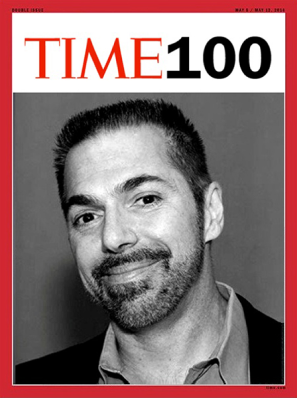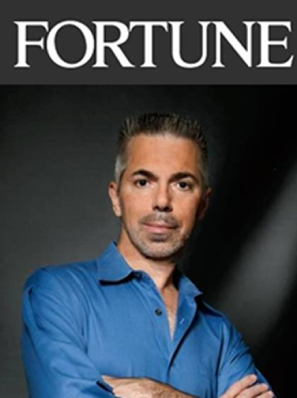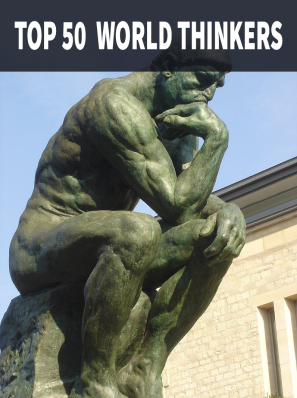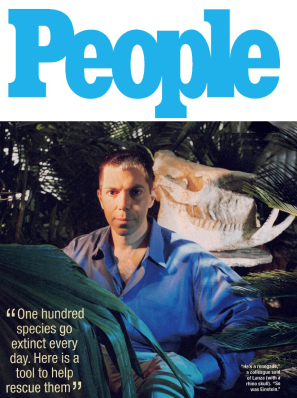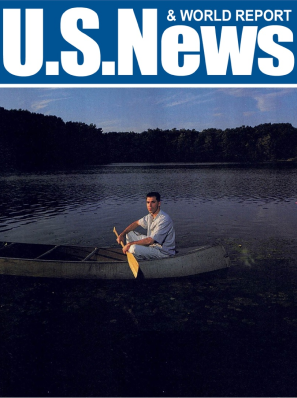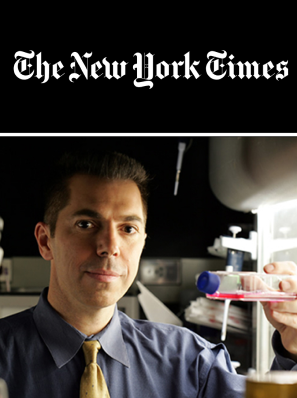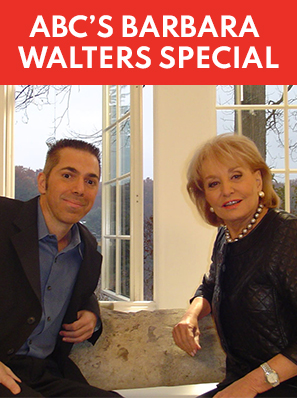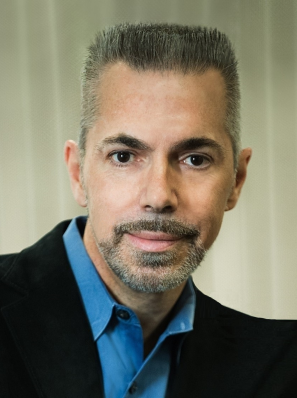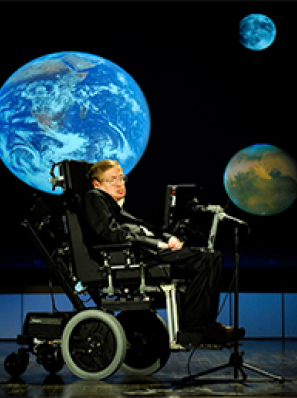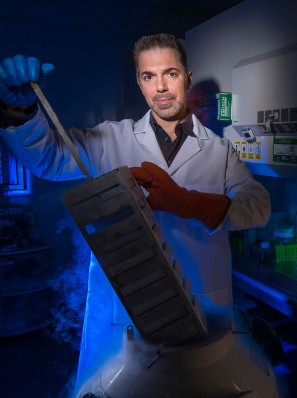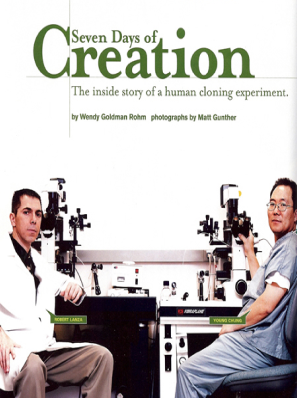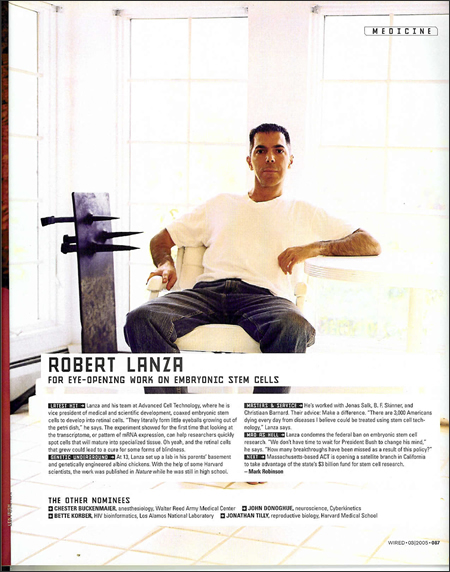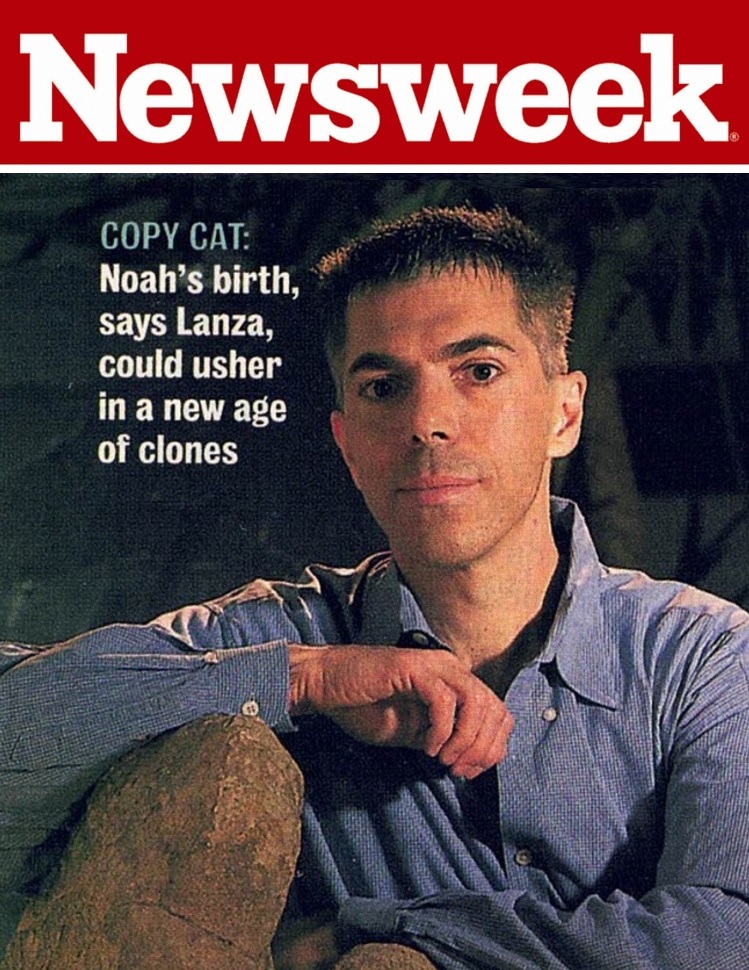WHY DO WE EXIST? EXPERIMENTS HOLD THE ANSWER
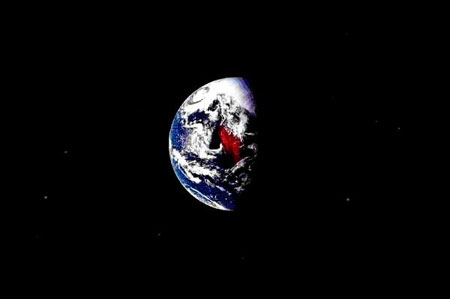
Why in the world do we exist? What sustains us in and above the void of nothingness?
A series of experiments hold the answer. I recall an ordinary day that made this obvious. Everyone was already at the hospital making morning rounds. “It doesn’t matter,” I thought as I scraped a patch of ice crystals off the window. “I’m already late.” Through the clear area I could see the underlying apparatus of the trees lining the road. The early morning sun slanted down, throwing into gleaming brightness the bare twigs. There was a feeling of mystery contained in that scene, a powerful feeling that something was veiled behind it that wasn’t accounted for in the scientific journals.
I put on my lab coat and set on my way to the university. As I strolled toward the hospital I had a curious impulse to detour round the biology pond. Perhaps I preferred to avoid harsh-etched things before my eyes at morning: the sight of the stainless-steel machines perhaps, or the stark lights in the operating room. It was this that had brought me to pause at the edge of the pond, in undisturbed quiet and solitude. Thoreau would have approved. “Poetry and art,” he wrote “and the fairest and most memorable of the actions of men, date from such an hour.”
It was comforting to overlook the pond, and watch the photons dancing on its surface like so many notes from Mahler’s Ninth Symphony. For an instant my body was beyond affection by the elements, and my mind merged with the whole of nature as much as it has ever been in my life. In that unassuming calm I saw nature, naked and unclothed, as she was for Eiseley and Thoreau. I headed back to the hospital, where morning rounds were nearly finished. A dying woman sat on the bed before me. Outside a songbird had its trill, sitting on a limb over the pond.
Later on, I thought of the secret denied me at dawn when I peeped through that little ice-crystal hole into the morning. “We are too content with our sense organs,” Eiseley once said. “It’s no longer enough to see as a man sees -− even to the ends of the universe.” Our radiotelescopes and supercolliders merely extend the perceptions of our mind. We see the finished work only. We don’t see how we are part of the whole, save for a space of perhaps five seconds on some glorious winter morning when all the senses are one.
We scientists have looked at the world for so long that we no longer challenge its reality. Here is the Universe: our sense organs perceive atoms and galaxies to some 14 billion light-years, although we can’t see with the eye of reason, that the world is for us merely a bundle of sensations unified by laws which exist in our understanding. We can’t see the laws that uphold the world; and that if they be removed, the trees and the mountains, indeed the whole Universe, would collapse to nothing.
According to biocentrism, time is the key. Physicists find that almost all models for reality from Newton’s laws through Einstein’s field equations, have no need for time. Time is a biocentric fabrication. To understand this, consider a movie of an archery tournament. If the projector stopped on a single frame, you’d know the position of the arrow with great accuracy −- its 20 feet just above the grandstand. But you’ve lost all information about its momentum. It’s going nowhere − its velocity is no longer known. This is the fuzziness described by the uncertainty principle: sharpness in one parameter causes blurriness in the other. Experiments show that such uncertainty is built into the fabric of reality. This only makes sense from a biocentric perspective: Time is the inner form of animal sense that animates events — the still frames of the spatial world. The mind animates the world like the motor of a projector, weaving spatial states into the “current” of life. It’s happening to you right now. Your eyes can’t see through the cranium; everything you perceive — even this page −- is being reconstructed inside your head.
At each moment we’re at the edge of a paradox described by the Greek philosopher Zeno. Since an object can’t occupy two places simultaneously, he contended an arrow is only at one place during any given instant of its flight. To be in one place, however, is to be at rest. The arrow must therefore be at rest at every instant of its flight, and motion is impossible. But is this really a paradox? Or rather, is it proof that time [motion] isn’t a feature of the outer, spatial world, but is rather a conception of thought?
Experiments confirm that Zeno was right. Scientists proved what in the world of quantum physics is equivalent to demonstrating that a watched pot doesn’t boil. This behavior — the “quantum Zeno effect” −- turns out to be a function of observation. “It seems,” said Peter Coveney, “that the act of looking at an atom prevents it from changing.” Theoretically, by the tenets of the Zeno effect, if a nuclear bomb were watched intently enough, it wouldn’t explode, that is, if you could keep checking its atoms every million trillionth of a second.
Bizarre? It’s hard to believe the Zeno effect is real. The problem lies not in the experiments, but in our way of thinking, in our failure to accept the evidence. While it’s true Zeno’s paradox can be “explained” through the application of sophisticated mathematical concepts, mathematics is just a way to quantify phenomena and shouldn’t be considered a replacement for it. The Zeno effect is a fact. The uncertainty principle is a fact. Biocentrism is the only humanly comprehensible way to explain them (quantum phenomena are only ‘weird’ in the context of the existing paradigm).
Time is the glue that holds the world together. Without rules to relate one frame (the “past”) with the next frame (the ‘present’) there could be no motion — indeed, life couldn’t exist. When asked if he believed in God, Einstein replied “There must be something behind the energy.” Indeed, that something is the mind. At the most irreducible level, space and time are defined by electromagnetic energy (E=mc2 tells us that all matter is made up of energy). The electric component generates a magnetic field, leapfrogging through space (at the speed of light) via a mathematical relationship that infuses temporal information into the bottom of the world.
This isn’t, you understand, an illusion. Spinoza’s genius sensed this back in the 17th century. To be conscious of space and time, he explained, is to transcend space and time. The mind transcends space and time in the sense that they are for it and it’s not in them. This is why, in real experiments with entangled particles, it appears that things are instantaneously connected behind the physical world as if there’s no space or time between them. This is also why, in yet other experiments, particles seem to spring into existence only when they’re observed. However, this is -− the critics will charge -− on the one hand, old news; on the other, headline-simplified.
For myself, five seconds on a winter’s morning is the most convincing evidence I should ever need. One can’t but come closer to God or Heaven than to merge oneself with the universal order of things. To become, as it were, part of nature. As Thoreau said of Walden Pond:
“I am its stony shore, And the breeze that passes o’er; In the hollow of my hand Are its water and its sand…
Robert Lanza, MD has published extensively in leading scientific journals, and has over two dozen books, including ‘Biocentrism,’ which lays out the full scientific argument for his theory of everything.
ANYTHING BEYOND THE UNIVERSE? NEW THEORY CHANGES OUR DESTINY
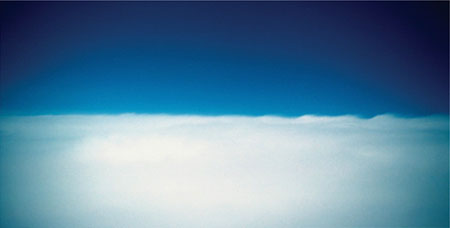
We think our destiny is to journey to Mars and beyond. Yet as we build our spacecraft, we’re about to be broadsided – from a different direction – by the most explosive event in history.
Sometime in the future science will be able to create realities that we can’t even begin to imagine. As we evolve, we’ll be able to construct other information systems that correspond to other realities, universes based on logic completely different from ours and not based on space and time.
Immanuel Kant declared in 1781 that space and time were real, but only indeed as properties of the mind. These algorithms are not only the key to consciousness, but why space and time − indeed the properties of matter itself – are relative to the observer. But a new theory called biocentrism suggests that space and time may not be the only tools that can be used to construct reality. At present, our destiny is to live and die in the everyday world of up and down. But what if, for example, we changed the algorithms so that instead of time being linear, it was 3-dimensional like space? Consciousness would move through the multiverse. We’d be able to walk through time just like we walk through space. And after creeping along for 4 billion years, life would finally figure out how to escape from its corporeal cage. Our destiny would lie in realities that exist outside of the known physical universe.
Even science fiction is struggling with the implications. In “Avatar,” human consciousness is infused into blue aliens that inhabit a wondrous world. However, according to biocentrism, replicating human intelligence or consciousness will require the same kind of algorithms for employing time and space that we enjoy. Everything we experience is a whirl of information occurring in our heads. Time is simply the summation of spatial states – much like the frames in a film – occurring inside the mind. It’s just our way of making sense of things. There’s also a peculiar intangibility to space. We can’t pick it up and bring it to the laboratory. Like time, space isn’t an external object. It’s part of the mental software that molds information into multidimensional objects.
We take for granted how our mind puts everything together. When I woke up this morning, I was in the middle of a dream that seemed as real as everyday life. I remember looking out over a crowded port with people in the foreground. Further out, there were ships engaged in battle. And still further out to sea was a battleship with radar antenna going around. My mind had somehow created this spatio-temporal experience out of electrochemical information. I could even feel the pebbles under my feet, merging this 3D world with my ‘inner’ sensations. Life as we know it is defined by this spatial-temporal logic, which traps us in the universe with which we’re familiar. Like my dream, the experimental results of quantum theory confirm that the properties of particles in the ‘real’ world are also observer-determined.
Loren Eiseley once wrote: “While I was sitting one night with a poet friend watching a great opera performed in a tent under arc lights, the poet took my arm and pointed silently. Far up, blundering out of the night, a huge Cecropia moth swept past from light to light over the posturings of the actors. ‘He doesn’t know,’ my friend whispered excitedly. ‘He’s passing through an alien universe brightly lit but invisible to him. He’s in another play; he doesn’t see us. He doesn’t know. Maybe it’s happening right now to us.'”
Like the moth, we can’t see beyond the footlights. The universe is just life’s launching-pad. But it won’t be rockets that take us the next step. The long-sought Theory of Everything was merely missing a component that was too close for us to have noticed. Some of the thrill that came with the announcement that the human genome had been mapped or the idea that we’re close to understanding the Big Bang rests in our innate human desire for completeness and totality. But most of these comprehensive theories fail to take into account one crucial factor: We’re creating them. It’s the biological creature that fashions the stories, that makes the observations, and that gives names to things. And therein lies the great expanse of our oversight, that until now, science hasn’t confronted the one thing that’s at once most familiar and most mysterious -consciousness.
Reality is simply an information system that involves our consciousness. Until we understand ourselves, we will continue to blunder from light to light, unable to discern the great play that blazes under the opera tent.
Robert Lanza, MD is author of “Biocentrism,” a new book that lays out his theory of everything.
DOES DEATH EXIST? NEW THEORY SAYS ‘NO’
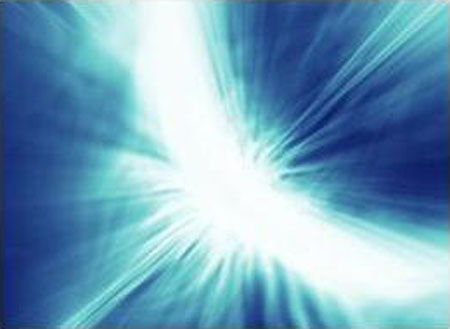
Many of us fear death. We believe in death because we have been told we will die. We associate ourselves with the body, and we know that bodies die. But a new scientific theory suggests that death is not the terminal event we think.
One well-known aspect of quantum physics is that certain observations cannot be predicted absolutely. Instead, there is a range of possible observations each with a different probability. One mainstream explanation, the “many-worlds” interpretation, states that each of these possible observations corresponds to a different universe (the ‘multiverse’). A new scientific theory – called biocentrism – refines these ideas. There are an infinite number of universes, and everything that could possibly happen occurs in some universe. Death does not exist in any real sense in these scenarios. All possible universes exist simultaneously, regardless of what happens in any of them. Although individual bodies are destined to self-destruct, the alive feeling – the ‘Who am I?’- is just a 20-watt fountain of energy operating in the brain. But this energy doesn’t go away at death. One of the surest axioms of science is that energy never dies; it can neither be created nor destroyed. But does this energy transcend from one world to the other?
Consider an experiment that was recently published in the journal Science showing that scientists could retroactively change something that had happened in the past. Particles had to decide how to behave when they hit a beam splitter. Later on, the experimenter could turn a second switch on or off. It turns out that what the observer decided at that point, determined what the particle did in the past. Regardless of the choice you, the observer, make, it is you who will experience the outcomes that will result. The linkages between these various histories and universes transcend our ordinary classical ideas of space and time. Think of the 20-watts of energy as simply holo-projecting either this or that result onto a screen. Whether you turn the second beam splitter on or off, it’s still the same battery or agent responsible for the projection.
According to Biocentrism, space and time are not the hard objects we think. Wave your hand through the air – if you take everything away, what’s left? Nothing. The same thing applies for time. You can’t see anything through the bone that surrounds your brain. Everything you see and experience right now is a whirl of information occurring in your mind. Space and time are simply the tools for putting everything together.
Death does not exist in a timeless, spaceless world. In the end, even Einstein admitted, “Now Besso” (an old friend) “has departed from this strange world a little ahead of me. That means nothing. People like us…know that the distinction between past, present, and future is only a stubbornly persistent illusion.” Immortality doesn’t mean a perpetual existence in time without end, but rather resides outside of time altogether.
This was clear with the death of my sister Christine. After viewing her body at the hospital, I went out to speak with family members. Christine’s husband – Ed – started to sob uncontrollably. For a few moments I felt like I was transcending the provincialism of time. I thought about the 20-watts of energy, and about experiments that show a single particle can pass through two holes at the same time. I could not dismiss the conclusion: Christine was both alive and dead, outside of time.
Christine had had a hard life. She had finally found a man that she loved very much. My younger sister couldn’t make it to her wedding because she had a card game that had been scheduled for several weeks. My mother also couldn’t make the wedding due to an important engagement she had at the Elks Club. The wedding was one of the most important days in Christine’s life. Since no one else from our side of the family showed, Christine asked me to walk her down the aisle to give her away.
Soon after the wedding, Christine and Ed were driving to the dream house they had just bought when their car hit a patch of black ice. She was thrown from the car and landed in a banking of snow.
“Ed,” she said “I can’t feel my leg.”
She never knew that her liver had been ripped in half and blood was rushing into her peritoneum.
After the death of his son, Emerson wrote “Our life is not so much threatened as our perception. I grieve that grief can teach me nothing, nor carry me one step into real nature.”
Whether it’s flipping the switch for the Science experiment, or turning the driving wheel ever so slightly this way or that way on black-ice, it’s the 20-watts of energy that will experience the result. In some cases the car will swerve off the road, but in other cases the car will continue on its way to my sister’s dream house.
Christine had recently lost 100 pounds, and Ed had bought her a surprise pair of diamond earrings. It’s going to be hard to wait, but I know Christine is going to look fabulous in them the next time I see her.
WHERE DID THE UNIVERSE COME FROM? NEW EXPLANATION OF OUR ORIGIN
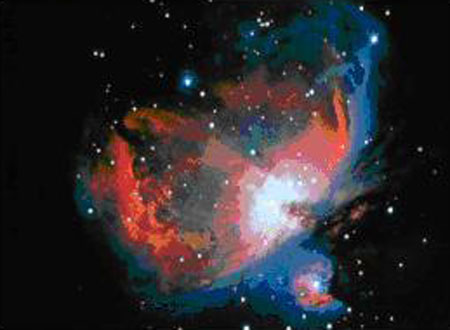
Contemporary science asks us to believe that the entire universe – indeed the laws of Nature themselves – just popped into existence one day out of nothing. How can anyone in their right mind accept such a thing?
We take physics as a kind of magic and don’t question that 14 billion years ago over a trillion quadrillion tons of matter suddenly appeared from – zilch? We’re told that space and time also magically appeared as well.
From the Big Bang to Sarah Palin is an enormous distance. It would be well to remember the experiments of Redi and Pasteur − experiments that put to rest the theory of spontaneous generation, the belief that life arose from dead matter (for instance, maggots from rotting meat, mice from bundles of old clothes) − and not make the same mistake for the origin of the Universe itself. We imagine time extending all the way backwards to the Big Bang, before life’s beginning in the seas. But experiments with real particles show that before matter can exist (or have properties) it has to be observed. Something must sustain it above the void of nonexistence and hold the world together in the midst of change. That something is the human (or animal) mind.
Past generations believed the world was a great ball resting on the back of a turtle; now science would have us believe it’s a fairy universe that appeared out of nowhere and that expands into nothing. Angels used to push and pummel the planets about; now everything is a meaningless accident. We’ve exchanged a world turtle for a Big Bang. By reminding us of its great successes at figuring out the mechanics of things, and fashioning marvelous new devices out of raw materials, science gets away with patently ridiculous ‘explanations’ for the nature of the universe as a whole. If only it hadn’t given us HDTV and the George Foreman grill, it wouldn’t have held our respect long enough to pull the old three-card-monte when it comes to these largest issues.
“One does occasionally observe,” Loren Eiseley wrote, “a tendency for the beginning zoological textbooks to take the unwary reader by a hop, skip, and jump from the little steaming pond…into the lower world of life with such sureness and rapidity that it is easy to assume that there is no mystery about this matter at all, or, if there is, that it is a very little one.” Science has sought to extend space and time beyond our own emergence. It followed our footsteps backwards until they disappeared into the sea. The cosmologists picked up the story of the molten Earth and carried it backwards in time through the lower forms of matter to the Big Bang.
But physics has learned that the world doesn’t exist in a definite state independent of the observer. Tracing life down through simpler stages is one thing, but assuming it arose spontaneously from nonliving matter wants for the rigor of the quantum theorist. I have seen the test-tube-like contraption that’s said to mimic the geophysical environment of the primitive earth, and that attempts to explain the origin of life in mechanistic terms without reference to any observer. While a variety of organic molecules can be synthesized in many ways − and it can even be done in your bathtub− the experiments do not fail to have an animal subject. Our intercourse with the molecules is necessary for them to exist as real objects. Half of the experiment is the scientist, who doesn’t recognize that their consciousness renders possible the space, indeed, the very reality of the vessel itself.
There is no invisible matrix out there that explains our origin. Rather, for each life there is a universe, its own universe. According to biocentrism, each of us generates our own sphere of reality. We carry space and time around us like turtles with shells. The Universe is comprised of billions of spheres of reality, a mélange whose scope is breathtaking. Strikingly, anything you don’t observe directly exists only as potential – or more mathematically speaking – as a haze of probability. “Nothing,” said John Wheeler, the great physicist “exists until it is observed.”
Since time doesn’t exist on any level before observers, traditional pre-Earth explanations of the universe can’t explain our origin. Think of the universe like one of those globes you see in the classroom – it’s merely a tool that represents everything that’s theoretically possible to experience. But like a CD, the music only leaps into reality when you play one of the songs. Instead of the Universe having an absolute beginning, imagine, instead, that existence is like a recording. Depending on where the needle is placed you hear a certain song. This is the present; the music, before and after is the past and future. All songs exist simultaneously, although we only experience them piece by piece.
“Let man,” declared Emerson, “then learn the revelation of all nature and all thought to his heart; this, namely; that the Highest dwells with him; that the sources of nature are in his own mind.” Scientists have failed to see beyond their equations, to see the birds and butterflies husbanding their colors above the grass and trees against the sky. If only, coming home from the laboratory, they would look out upon the pond, and through the bulrushes, watch the schools of minnows rise to the surface to behold that vaster universe of which they are an intricate part.
We’re living through a profound shift in worldview, from the belief that life is an insignificant part of the physical universe (and sprung into existence from the Big Bang or bundles of old clothes), to one in which we – not the Big Bang – are the origin. Only for a moment, while we sort out the reality that time and space don’t exist without us, will it feel like madness.
Robert Lanza, MD is author of “Biocentrism,” a new book that lays out his theory of everything.
DO YOU ONLY LIVE ONCE? EXPERIMENTS SUGGEST LIFE NOT ONE–TIME DEAL
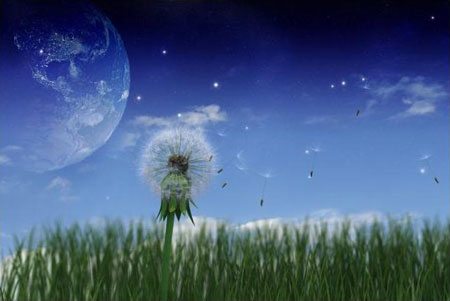
We think we die and rot into the ground, and thus must squeeze everything in before it’s too late. If life — yours, mine — is a just a one-time deal, then we’re as likely to be screwed as pampered. But experiments suggest this view of the world may be wrong.
The results of quantum physics confirm that observations can’t be predicted absolutely. Instead, there’s a range of possible observations each with a different probability. One mainstream explanation, the “many-worlds” interpretation, states that there are an infinite number of universes (the “multiverse”). Everything that can possibly happen occurs in some universe. The old mechanical — “we’re just a bunch of atoms” −- view of life loses its grip in these scenarios.
Biocentrism extends this idea, suggesting that life is a flowering and adventure that transcends our ordinary linear way of thinking. Although our individual bodies are destined to self-destruct, the “me” feeling is just energy operating in the brain. But this energy doesn’t go away at death. One of the surest principles of science is that energy never dies; it can neither be created nor destroyed. When we die, we do so not in the random billiard ball matrix but in the inescapable life matrix. Life has a non-linear dimensionality −- it’s like a perennial flower that returns to bloom in the multiverse.
A series of landmark experiments show that measurements an observer makes can influence events that have already happened in the past. One experiment (Science 315, 966, 2007) confirmed that flipping a switch could retroactively change a result that had happened before the switch was flipped. Regardless of the choice you, the observer, make, it’ll be you who will experience the outcomes −- the universes −- that will result. The implications of this were clear with my sister “Bubbles.” The earliest remembrance I have of my childhood was with her, in her play doctor’s office. “You’re a little unwell,” she said, handing me a cup of sand. “It’s medicine. Drink this and you’ll feel better.” This I did; and as I started to drink it, Bubbles cried out “No!” and gave a gasp as if she were swallowing it herself.
The affection that existed between Bubbles and me was a strong one, for being my older sister, she had always felt that it was her job to protect me. I can remember standing at the school bus stop with my little mittens and lunchbox, when one of the older neighborhood boys pushed me to the ground. I was still on the ground and hurt, when I saw Bubbles running up the street. “You touch my little brother ever again,” she said, “and I’ll punch your face in.”
It’s difficult to believe that I, and not she, went on to become the doctor. Although she was very bright, by 10th grade she’d dropped out of school and entered on a course of destruction with drugs. The ill done to her at home had little remission. She was beaten, ran away, and punished again. I recall her hiding under the porch, and the terror that hung about the place; I can see the tears running down her face. After moving out of the house I learned she was pregnant. When all the relatives refused to go to her wedding, I told her “It’s okay!” and held her hand. The birth of “Little Bubbles” was a happy occasion, an oasis in this life in the desert. How happy she was, and when I sat down by her side, she asked me −- her little brother −- if I’d be the godfather to her child.
But all this was a short event, and stands like a wild flower along an asphalt road. Little by little her mind began to deteriorate. Although I’d seen a lot of medicine by then, it was a matter of some emotion to me to see her child taken away. The deep remembrance I have of her being utterly without hope, restrained and sedated with drugs. As I went away from the hospital that day, I mingled my memories of her with tears.
Bubbles was still a pretty woman, and was found in the park once, quite distressed, her hair hanging in her face and her clothes torn; of which she knew as little as us. A while later she was pregnant, and I can only understand that someone had taken advantage of her again. I remember her looking at me in embarrassment, holding the baby in her arms. He had a cute face, and I thought, didn’t look like anyone we knew.
Soon after, my big sister −- a once proud woman −- lost even the remembrance of where she lived.
This tale of Bubbles is one that has a thousand variations, told by many families, of tragedy interspersed with joyous times. But plays of experience, even ones like that of my sister, are never random, nor the end of the story. Rather, they’re interludes in a melody so vast and eternal that human ears can’t appreciate the tonal range of the symphony.
“Whenever anything in nature seems to us ridiculous, absurd or evil,” said Spinoza “it is because we have but a partial knowledge of things.”
Life has a power that transcends any individual history or universe. The story of my sister is part of a more profound drama, one that I know holds more joyful fortunes as her life unfolds in the multiverse. As in the Science experiment, whether it’s flipping a switch or making other choices, she will experience the many outcomes and resulting universes. I only hope -− if she becomes a doctor −- the medicine goes down a lot easier than it did in her play-office so long ago.
Robert Lanza, MD has published extensively in leading scientific journals, and has over two dozen books, including ‘Biocentrism’ (with astronomer Bob Berman), which lays out the full scientific argument for his theory of everything.
JUDGEMENT DAY IS COMING. SCIENCE SUGGESTS JUSTICE IS INESCAPABLE
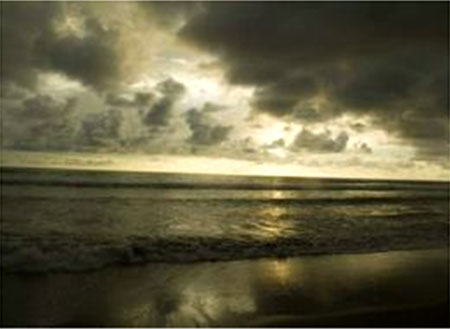
Will kind people be rewarded for their good deeds? Will the wicked be punished? Yes, according to a new interpretation of recent experiments. Although our science is too primitive for us to fully comprehend, there is a direct and proportional price to pay for any act of cruelty or injustice.
Science suggests that there are consequences to our actions that transcend our ordinary, classical way of thinking. Emerson, it turns out, was right: “Every crime is punished, every virtue rewarded, every wrong redressed, in silence and certainty.”
I remember fishing on a warm summer night. Now and then I could feel the vibrations along the line linking me with the life prowling about the bottom. At length I pulled some bass, squeaking and gasping into the air. It was a puzzle to feel a tug, and to be conscious in that precise moment of a part of me, which, as it were, was not a part of me, but scale and fin, circling the hook, slow to strike.
Surely this is what Spinoza, the great philosopher, meant when he contended that consciousness cannot exist simply in space and time, and at the same time is aware of the interrelations of all parts of space and time. In order to have knowledge of a pout or a pickerel, I must have somehow been identical with them.
But how can this be? In experiments, it has been repeatedly shown that a single particle can be at two places at the same time. See the loon in the pond or the dandelion in the field. How deceptive is the space that separates them and makes them solitary. They are the subjects of the same reality that interested John Bell, who proposed the experiment that answered the question of whether what happens locally is affected by nonlocal events.
Experiments from 1997 to 2007 have shown that this is indeed the case. Physicist Nicolas Gisin sent entangled particles zooming along optical fibers until they were seven miles apart. But whatever action they took, the communication between them happened instantaneously. Today no one doubts the connectedness between bits of light or matter, or even entire clusters of atoms. They’re intimately linked in a manner suggesting there’s no space between them, and no time influencing their behavior. In fact, just last year, Gisin announced a new twist on his experiment; in this case, he thinks the results will be visible to the naked eye.
In the same way, there is a part of us that is connected to the fish in the pond. It is the part that experiences consciousness, not in our external embodiments but in our inner being. And although we identify ourselves with our thoughts and affections, it is an essential feature of reality that we experience the world piece by piece.
Everything you experience is a whirl of information occurring in your head; according to Biocentrism, space and time are simply the mind’s tools for putting it all together. However solid and real the walls of space and time have come to look, there is a part of us that is no more human than it is animal − even the fish, sporting there in the pond, a part of us unwittingly tempted by a bunch of worms strung on a thread.
As parts of such a whole there is justice. The bird and the prey are one. This was the world that confronted me that warm summer night. From the shore I could see the shiners dimpling the water with their tails in the moonlight. A bug furrowed the water, making a conspicuous ripple, which the fishes darted at. Only two diverging lines stood between them and natural justice.
“Non-separability,” said physicist Bernard d’Espagnat, “is now one of the most certain general concepts in physics.”
We suppose ourselves to be a pond; and if there is any consequence to our actions, if there is any justice, it must approach upon these shores. Yet that night, I sensed the union that the one man and creature has with the other. The fish and I, the criminal and the victim, are one and the same.
Justice is built into the fabric of nature. Make no mistake about it: it will be you who looks out the eyes of the victim. Or you can be the recipient of kindness — whichever you choose.
The problem is that even web scientists are just earthworms beginning to grasp the non-linear dimensionality of nature. Heinz Pagels, the esteemed theoretical physicist, once stated: “If you deny the objectivity of the world, unless you observe it and are conscious of it (as most physicists have), then you end up with solipsism − the belief that your consciousness is the only one.”
This may not unsettle you, except perhaps on a warm moonlit night with a fish gasping for life at the end of your rod. I knew then, at that moment, that Pagel’s conclusion was right. Only it wasn’t my consciousness that was the only one, it was ours. According to biocentrism, our individual separateness is an illusion. Remember the words of Omar, who “never called the One two,” and of the old Hindu poem: “Know in thyself and All one self-same soul; banish the dream that sunders part from whole.”
There was no doubt; that consciousness which was behind the youth I once was, was also behind the mind of every animal and person existing in space and time. “There are,” wrote Loren Eiseley, noted anthropologist, “very few youths today who will pause, coming from a biology class, to finger a yellow flower or poke in friendly fashion at a sunning turtle on the edge of the campus pond, and who are capable of saying to themselves, ‘We are all one − all melted together.'”
Yes, I thought, we are all one. I let the fish go. With a thrash of the tail, I disappeared into the pond.
Robert Lanza, MD is author of over two dozen scientific books, including “Biocentrism,” a new book that lays out his theory of everything.
